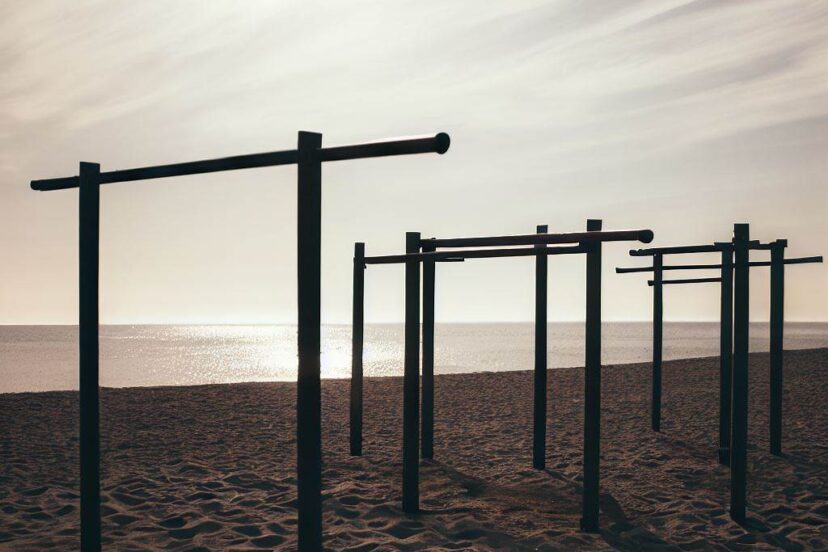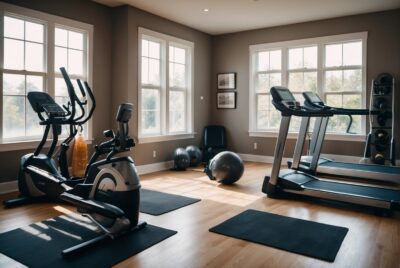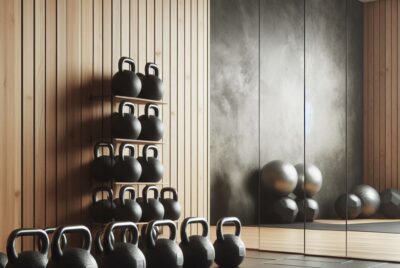Calisthenics Bars: Mastering Movement
*We may earn a commission for purchases made using our links. Please see our disclosure to learn more.
Calisthenics Bars: Optimize Your Bodyweight Training Routine
Calisthenics bars are essential tools for anyone looking to engage in bodyweight training. As a practitioner myself, I appreciate the simplicity and effectiveness of using bars for various exercises. They enable a wide range of movements, from basic pull-ups to more advanced calisthenics exercises like muscle-ups and levers. The right set of bars can transform a corner of your home into a versatile bodyweight gym, providing a sturdy and safe way to train different muscle groups effectively.

Quality and design vary widely in the calisthenics equipment market, but there’s no denying the importance of robust construction. I’ve noticed that the most reliable bars are typically made of steel and can handle significant weight, ensuring safety and stability during intense workouts. Adjustable features, such as height on dip bars or modularity in power towers, add great value, catering to different body types and workout preferences.
Having a personal set of calisthenics bars at home is not just convenient; it’s a commitment to a fitness lifestyle that prioritizes strength, mobility, and functional movement. Whether you are a beginner or an experienced athlete, incorporating calisthenics bars into your routine can lead to impressive strength gains and advancements in your overall calisthenics skills. The key is to choose equipment that matches your fitness level and goals, as well as the space you have available.
Understanding Calisthenics Bars

Calisthenics bars are key pieces of equipment for enhancing strength through bodyweight exercises. They cater to a range of movements that support gymnastic and calisthenic training.
Types of Calisthenics Bars
- Pull-Up Bars: These can be mounted as permanent fixtures or placed in door frames temporarily. They enable exercises like pull-ups and chin-ups which are great for back strength.
- Dip Bars: Usually found as parallel bars or parallettes, dip bars support exercises targeting the chest, triceps, and shoulders. They allow for a range of movements, including dips and L-sits.
- Specialized Bars: This category includes gymnastic rings and push-up bars. Rings offer instability that challenges the core, while push-up bars can enhance wrist positioning and deepen the range of motion.
Benefits of Calisthenics Bars
- Full Body Workout: By leveraging different types of calisthenics bars, I can engage nearly every muscle group, from legs to core and upper body.
- Versatility: Especially beneficial for home gyms, these bars require minimum space but provide maximum exercise variety.
- Improves Gymnastic Skills: For aspiring gymnasts, practicing on calisthenics equipment like parallel bars and rings can improve technique and strength for gymnastic routines.
Key Exercises With Calisthenics Bars

Calisthenics bar exercises play a pivotal role in building strength and enhancing body control. Here, I’ll introduce essential exercises that target various muscle groups using calisthenics bars.
Push-Ups and Variations
When I perform push-ups on a calisthenics bar, I can increase the range of motion compared to floor push-ups. I often include different grip positions to target my chest, shoulders, and back muscles more effectively.
- Standard Grip: Keeping my hands shoulder-width apart to focus on my chest.
- Wide Grip: Placing my hands wider than my shoulders to emphasize my outer chest and shoulders.
Dips and Triceps Work
Dips are integral for developing my triceps and they enhance shoulder stability. The correct form is crucial:
- I grasp the bars and hoist myself up to a starting position.
- Lowering my body, I keep my elbows close to my body.
- I engage my core to stabilize myself throughout the movement.
L-Sits and Core Engagement
The L-sit exercise is excellent for improving my core strength and balance. To execute an L-sit:
- I sit with my legs straight out in front of me.
- Placing my hands on the bars, I press down and lift my body, keeping my legs parallel to the ground.
Pull-Ups and Arm Strength
Pull-ups are a mainstay in my calisthenics routines for enhancing arm and upper body strength. Here’s my approach to performing pull-ups correctly:
- I grip the bar with my palms facing away from me.
- Ensuring my form is strict, I pull myself up until my chin is over the bar, then lower myself back down with control.
In my regimen, I regard these exercises as crucial for establishing a well-rounded calisthenics practice, and they each play a vital role in my development of balance, core strength, and overall muscular endurance.
Setting Up Your Home Gym

When I consider setting up a home gym for calisthenics, my focus is on selecting stable and affordable equipment that maximizes space and ensures safety.
Choosing the Right Equipment
The foundation of my home gym consists of key calisthenics equipment that offers versatility for a variety of exercises. I opt for dip bars and gymnastic rings as they provide a full-body workout and cater to movements like push-ups, dips, and more advanced exercises like planches. I also incorporate monkey bars for grip strength and dynamic movements. Yoga mats are essential for floor exercises and stretching.
Installation and Space Optimization
When installing equipment, I ensure adequate spacing between apparatuses for safety and functionality. Dip bars and gymnastic rings need solid anchoring and enough clearance for exercises like L-sits and pull-ups. My approach involves measuring out space to promote free movement and considering the equipment’s footprint.
Safety Considerations
Safety is paramount in my home gym. All equipment must be stable to prevent injury. I ensure dip bars are well-grounded, and gymnastic rings are securely fastened to the ceiling or a sturdy frame. I also keep a clear perimeter around each piece of equipment to avoid any obstructions during my workouts.
Advancing Your Calisthenics Practice

In my journey with calisthenics, I’ve found that systematic progressions, resistance variations, and well-rounded programming are vital for advancing my practice.
Progressions and Skill Development
I focus heavily on progressions, particularly when it comes to pull-ups, which are a cornerstone of functional fitness. For beginners, modifying the pull-up to an easier variation like negative pull-ups or assisted pull-ups using a band can help develop the necessary strength. As muscle groups adapt, I transition to more challenging progressions like the L-sit pull-up, increasing the intensity at a measured pace.
To advance, I track my progress with specific goals, such as mastering a certain number of consecutive pull-ups or achieving a front lever. These goals help maintain a trajectory of improvement and keep my workouts challenging.
Incorporating Resistance and Bands
Adding resistance bands to my calisthenics routine is an effective way to intensify exercises and target muscle groups more directly. Bands can decrease or increase the difficulty of bodyweight exercises, depending on how I use them. For exercises like pull-ups or dips, I use bands to provide assistance initially. As I progress, I use heavier bands to add resistance, thereby increasing the difficulty and stimulating muscle growth.
- Beginners: Light resistance bands for assistance
- Intermediate: Medium bands for moderate assistance or resistance
- Advanced: Heavy bands for substantial resistance
Creating a Balanced Program
My program aims to include a variety of bodyweight exercises that target all major muscle groups for a balanced approach to functional fitness. I schedule my routine to cover push, pull, core, and leg exercises throughout the week:
- Monday: Pull focus (pull-ups, rows)
- Wednesday: Push focus (push-ups, dips)
- Friday: Leg focus (squats, lunges)
- Sunday: Core focus (planks, hanging leg raises)
By varying the exercises and gradually increasing the difficulty, the body adapts and my strength and control over movements improve. Additionally, rest days are crucial for recovery, ensuring muscles have time to rebuild and strengthen.
Equipment Maintenance and Upgrades
In my experience with calisthenics equipment, I’ve recognized that maintaining my bars has a significant impact on their longevity and performance. Knowing when to upgrade can enhance my workout experience and safety.

Maintaining Your Calisthenics Bars
Consistency is the key. I always ensure to regularly check my calisthenics bars for any signs of wear or damage, regardless of whether it’s a pull-up bar, dip station, or power tower. Here’s what I pay attention to:
- Joints and Connections: Any loose bolts can compromise stability. I make it a point to tighten them periodically.
- Surface Check: For rust or chipping, especially if my equipment is outdoors. I sand and reapply protective paint when needed.
- Grip Areas: I clean the grips to maintain traction and prevent slippage, which is vital for performing exercises like pull-ups and dips safely.
When to Upgrade
Deciding to upgrade is a strategic choice. I assess my calisthenics bars by considering:
- Weight Capacity: If I’ve gained strength and I’m loading more weight than before, checking the max load of my dip station or power tower is crucial to avoid dangerous failures.
- Functionality: If new techniques or exercises are part of my regimen, I confirm whether an upgrade would provide the necessary features.
- Wear and Tear: Excessive wear that compromises safety, despite regular maintenance, is a clear indicator it’s time to seek replacement.
By adhering to these maintenance and upgrade guidelines, I keep my workouts both effective and safe.
Frequently Asked Questions
When exploring calisthenics equipment, it’s important to consider factors like quality, durability, and suitability for your fitness level and space. Let’s address some common inquiries to aid in making informed decisions.
1. What are the best calisthenics bars suitable for home use?
For home workouts, I recommend adjustable-height dip bars with sturdy construction, such as 14-gauge steel. Look for equipment like the Sportsroyals Power Tower that caters to various exercises including pull-ups and dips.
2. How can beginners choose the right calisthenics equipment?
Beginners should seek calisthenics bars that are stable, with non-slip bases to prevent accidents. Bars that offer versatility, like push-up and dip bars with adjustable heights, are ideal for progressively challenging workouts.
3. What are the advantages of using a pull-up bar for calisthenics training?
Pull-up bars enhance upper body strength by targeting muscles in the back, shoulders, and arms. Their stability allows for diverse exercises such as pull-ups, chin-ups, and leg raises, which are central to calisthenics progress.
4. Where can one purchase high-quality calisthenics bars?
High-quality calisthenics bars are available through sports equipment retailers, online fitness stores, and marketplaces. It’s essential to purchase from reputable sellers to ensure safety and equipment longevity.
5. How do calisthenic holds contribute to muscle development?
Calisthenic holds, such as the plank or L-sit, engage multiple muscle groups simultaneously. This promotes increased muscular endurance and core stability, which are fundamental in the progression of calisthenics skills.




